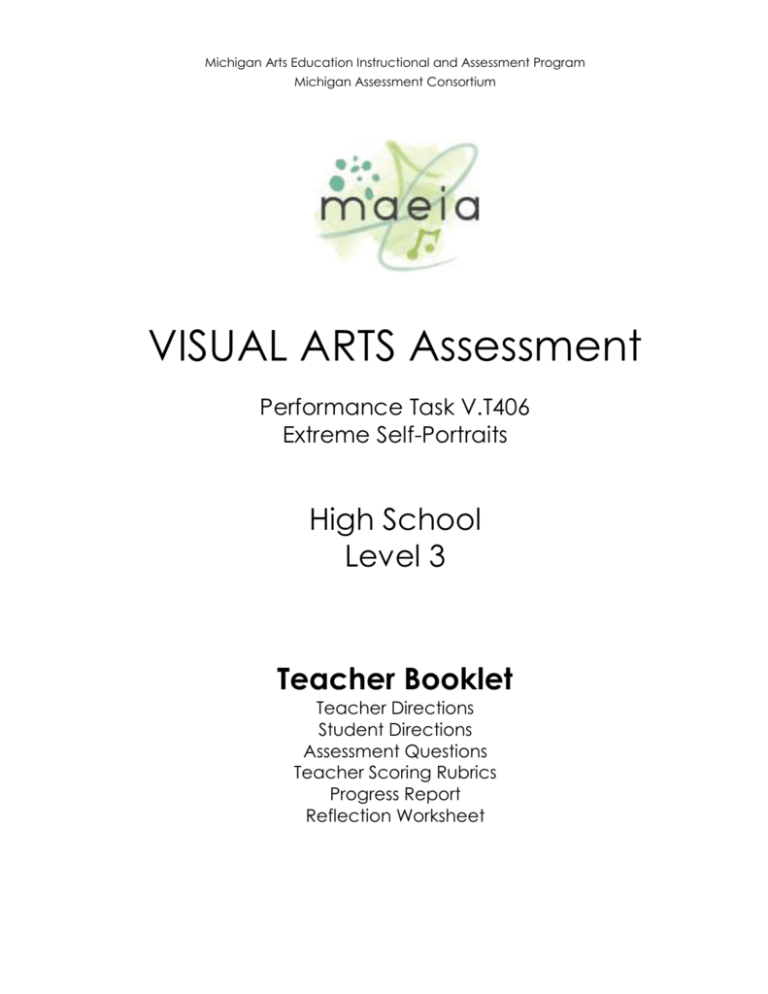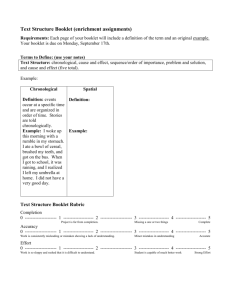
Michigan Arts Education Instructional and Assessment Program
Michigan Assessment Consortium
VISUAL ARTS Assessment
Performance Task V.T406
Extreme Self-Portraits
High School
Level 3
Teacher Booklet
Teacher Directions
Student Directions
Assessment Questions
Teacher Scoring Rubrics
Progress Report
Reflection Worksheet
ACKNOWLEDGEMENTS
Self-Portrait by Albrecht Durer, 1498, in the public domain.
Self-Portrait with Bonito, Frida Kahlo, 1941. Oil on canvas, 55 x 43.4 cm, private
collection, United States / Frida Kahlo Trust.
Self-Portrait with Bandaged Ear, 1889. Oil on canvas, 51 x 45 cm, in the public
domain.
© 2014 by the Michigan Department of Education.
All rights reserved. No part of this publication may be reproduced or transmitted, in any form or by any means, electronic
or mechanical, including photocopying, recording, or any information storage and retrieval system, without permission in
writing from the Michigan Department of Education. Portions of this work may have been previously published. Printed in
the United States of America.
1
Michigan Student Learning Standards Assessed
Performance
Standard(s)
VA.HS.P.1–Students can intentionally select and apply
materials and organizational principles to solve specific
visual arts problems.
Content Standard
ART.VA.I.HS.2–Intentionally use art materials and tools
when applying techniques and skills to communicate ideas.
VPA Guidelines
P.3–Describe and consider relationships among the intent of
the student artist, the results of the artistic/creative process
and a variety of potential audiences or users.
Intended Students
Third- or fourth-year (Level 3) visual arts students
OVERVIEW AND OUTLINE OF THE PERFORMANCE TASK
During her 30-year career, New York–based artist Cindy Sherman has taken
photographs of women. In those photos she is not only the photographer but also the
subject. Cindy Sherman’s career has addressed a variety of issues, from society’s
perception of women and their perception of themselves to cultural stereotypes and
identity. Cindy Sherman’s art will be the inspiration for this photo assignment.
In teams of two (or by themselves if they prefer), students will set up photos of
themselves portraying roles played out in our culture at large, youth culture, and/or
your own high school’s culture. Alternatively, students could portray themselves in
roles they may take on in 5, 10, or 20 years. How do your students see themselves in the
future? This series of 12 quality photos should portray each student in two or more
different roles. This will require work outside of class, utilizing clothes, costumes,
makeup, and other props that they have at home, or that they borrow or buy from a
thrift shop, etc. Students may need to seek out potential setting locations.
This assessment has six parts to it:
o Part 1–Assessment Questions (Day 1)
o Part 2–Brainstorming with a Partner (Day 1)
o Part 3–Photographing (Days 2–9)
o Part 4–Midpoint Report and Submission of First Six Photographs (Day 10)
o Part 5–Photographing (Days 11–20)
o Part 6–Submission of Final Six Photographs and Reflection (Day 21)
Note: Elements of Cindy Sherman’s work have been considered controversial by some.
Please preview the Art 21 video and decide for yourself how much of it you wish to
show to your students. It is 17 minutes long; the first seven minutes (from 15:40 to
22:45) are enough to give the students an idea of her work and her process. If you wish
to show the entire clip, please review it in advance to assure compliance with your
school’s policies and community norms.
If you’d rather not use Cindy Sherman’s work, artists from Rembrandt to Van Gogh to
Alice Neal to Alex Katz have painted themselves and others and may be used as
classroom examples, as well as portrait photographer Yousuf Karsh.
2
SUGGESTED TOTAL TIME
Most of this project is done outside of class. Because it is done off-site, three weeks or
21 days are used interchangeably. These are calendar days (including weekends), not
school days. Only three class periods (Days 1, 10, and 21) are required for work that
students should do in class.
LIST OF MATERIALS REQUIRED
The following materials are required for this assessment:
o Student Booklets
o Pens or pencils
o One camera (phone or digital) for every one or two students
o Flash drive or cloud-based method on submission days to save or access student
offsite work
o Digital server to which students can submit work (if this is not available, they may
simply submit their flash drives)
o Digital projector to show Art21 video introducing the project
o Video on Cindy Sherman’s work and process (http://www.pbs.org/art21/watchnow/segment-cindy-sherman-in-transformation), plus other videos students may
find on their own
ASSESSMENT SETUP
On the first day, a room with a digital projector is needed. On Days 10 and 21,
computers should be available for students to upload their portfolios to the school
server. If a server isn’t available, have students submit their work on flash drives.
DETAILED SCRIPT WITH TEACHER AND STUDENT DIRECTIONS
Directions for teachers are in regular print. Directions to be read to students are in bold.
When you are ready to begin, say:
Begin by filling in the information requested on the front cover of your Student
Booklet.
Pause while students fill in the requested information. Then say:
Turn to page 2 and read the directions silently as I read them to you.
Pause while students turn to page 2. Then say:
This assessment has six parts to it:
o
o
o
o
Part 1–Assessment Questions (Day 1)
Part 2–Brainstorming with a Partner (Day 1)
Part 3–Photographing (Days 2–9)
Part 4–Midpoint Report and Submission of First Six Photographs (Day 10)
3
o Part 5–Photographing (Days 11–20)
o Part 6–Submission of Final Six Photographs and Reflection (Day 21)
The directions for each part are given in the Student Booklet.
PART 1–ASSESSMENT QUESTIONS (DAY 1)
This assessment begins with five assessment questions. Turn to page 14 in your
Booklet. First, write your name in the space provided on page 14 and read the
Teacher Scoring Rubric—Curator’s Commentary on pages 15–16. Then read and
respond to the questions. You have 15 minutes to complete your responses.
When you are finished, tear off pages 14–16 and give them to your teacher.
Pause while students work on the task. After 15 minutes, say:
Time is up. Tear off pages 14–16 and give them to your teacher.
PART 2–BRAINSTORMING WITH A PARTNER (DAY 1)
During her 30-year career, New York–based artist Cindy Sherman has taken many
photographs of women. In those photographs she is not only the photographer
but also the subject. Cindy Sherman’s career has addressed a variety of issues,
including society’s perception of women and their perception of themselves, as
well as cultural stereotypes and identity. Your teacher will show you some of her
work.
Show seven minutes (from 15:40 to 22:45) of the video found at the link below as an
introduction to the project:
http://www.pbs.org/art21/watch-now/segment-cindy-sherman-in-transformation
If you’ve previewed additional footage of the video, you have found it appropriate, and
there is time, feel free to show all 17 minutes of it. Use your discretion about showing
the last 10 minutes of the video.
This assessment will be done mostly as an out-of-class assignment. The due date
is three full calendar weeks or 21 days from today.
In teams of two (or by yourself if you prefer), set up photographs of yourself
portraying roles you see played out today in our culture at large, in youth culture,
and/or in your own high school’s culture. Alternatively, you could portray
yourselves in roles you may take on in 5, 10, or 20 years from now. How do you
see yourself in the future? How would you show that?
Portray the subject in a setting consistent with the role and set up your subject in
a way that reflects your school’s standards of decency and appropriateness. Edgy
and/or thoughtful can still be school-appropriate.
4
Your setting can be digitally added if you want. In your series of photographs, you
should be portrayed in two or more roles. You can focus on a more in-depth study
of two roles, or you may want to select up to six roles and have two quality
photographs of each. Your completed series will consist of 12 quality digital
photos to be uploaded to a designated website or server.
This will require work outside of class, utilizing clothes, costumes, makeup, and
other props that you have at home, or that you borrow or buy from a thrift shop,
etc. You may need to seek out potential setting locations.
The Checklist for Your Series of Extreme Self-Portraits, given on page 3 in your
Booklet, provides the details of this task for your future reference. Review the
Checklist now.
CHECKLIST FOR YOUR SERIES OF EXTREME SELF PORTRAITS
Portray the subject in a setting consistent with the role you have chosen.
Set up your subject in a way that reflects your school’s standards of decency
and appropriateness. Edgy and/or thoughtful can still be school-appropriate.
Digitally add or enhance the setting if it serves your artistic goal.
Portray yourself in at least two roles and as many as six roles, having at least
two quality photos of each role.
Upload six portraits with a description of work-to-date on Day 10.
Upload the remaining six photos on Day 21. Your completed series will consist
of 12 quality digital photos.
Write your reflections on this assessment on Day 21.
You will take many more than 12 photographs to acquire 12 quality ones. The
photographs should speak for themselves. You will also be asked to reflect on
your creative process in writing during and at the conclusion of the project.
You are allowed three weeks to complete this project, but you will have a
Progress Report due ten days from today. Your teacher will tell you what day that
is. At that time, you will be required to have half of your work completed. Six of
your digital photographs should be uploaded to the server by that date.
On Day 21, the date that your teacher gave you for completion of this assessment,
the full portfolio of work, made up of your 12 best photographs, is to be turned in.
No late work will be accepted.
On Day 21 you will also spend time reflecting on the project in writing. You are
welcome to bring any notes or thoughts that you have already written down to
class that day. The Teacher Scoring Rubric that will be used to assess your work is
on pages 4–5. Read level 4, the highest level of performance.
Once you have decided on your partner, you should brainstorm and create a list
of the kinds of social roles you want to consider. Add to that list as you move
through the project. It will be referenced when you do your reflection at the end,
5
so keep track of it. Begin your brainstorming now. You will work with your
partner taking photographs every class period until Day 10 when you will write a
progress report.
6
TEACHER SCORING RUBRIC
Dimension
Creativity
Collaboration
Teacher
assessment will
be based on
responses of
student pair to
Reflection
Question 3. If
student worked
alone,
disregard this
section.
Craftsmanship
1
Uses the first idea
that comes to
mind.
Unwilling to
explore a variety
of possibilities.
Uses others’ ideas
instead of his/her
own for variety
and
selection of
subjects and
backgrounds.
Only one role
depicted or
assignment
incomplete.
You and your
partner were not
able to work
together. You
often disagreed.
You were seldom
able to work out
logistical
challenges. The
technical abilities
of your teammate
were limited.
Your partner took
photos that were
not to your liking.
Work is
incomplete and/
or shows no
evidence of the
intentional use of
these formal
elements in the
body of work:
1. Composition
2. Contrast
3. Cropping
4. Selective focus
5. Careful
attention to
telling details.
2
Develops and
refines ideas
through limited
investigation.
Doesn’t recognize
conventional
thinking and work
is predictable for
variety and
selection of
subjects and
backgrounds.
From two to six
roles depicted,
but with little
variety.
3
Develops and
refines ideas
through
investigation.
Recognizes
conventional
thinking and
offers some
alternatives for
variety and
selection of
subjects and
backgrounds.
From two to six
roles depicted.
4
Develops and
refines many ideas
through extensive
investigation.
Recognizes
conventional
thinking and offers
many alternatives
for variety and
selection of
subjects and
backgrounds. From
two to six roles
depicted with
insight, style, and
daring.
You and your
partner did not
work especially
well together.
Your ideas often
conflicted, so it
was hard to make
decisions. You
were able to work
out logistic
challenges some,
but not all, of the
time. The
technical abilities
of your teammate
were limited.
Your partner took
acceptable photos.
One to two of
these formal
elements appear
to be used
intentionally to
create a body of
work:
1. Composition
2. Contrast
3. Cropping
4. Selective focus
5. Careful
attention to
telling details.
You and your
partner worked
well together.
Some of your
ideas even
inspired one
another. You
were able to
work out logistic
challenges. The
technical abilities
of your teammate
supported your
conceptual ideas.
Your partner
took good
photos.
You and your
partner worked
extremely well
together. Your
ideas inspired one
another. You were
able to work out
logistical
challenges. The
technical abilities
of your teammate
enhanced your
conceptual ideas.
Your partner took
excellent photos.
Three to four of
these formal
elements appear
to be used
intentionally in a
creative body of
work:
1. Composition
2. Contrast
3. Cropping
4. Selective focus
5. Careful
attention to
telling details.
Excellent use of all
five of these formal
elements to create
an exemplary body
of work:
1. Composition
2. Contrast
3. Cropping
4. Selective focus
5. Careful attention
to telling details.
7
Reflection
Student’s written
work is
incomplete.
Student’s ability
to reflect on
his/her own
art-making is
limited.
Student makes an
effort to articulate
his/her intention
and process with
limited success.
Some recording of
observations and
reflections.
Student is able to
articulate his/her
intention and
process.
Recording of
observations and
reflections with
personal insight.
Student is able to
articulate in detail
his/her intention
and process.
Comprehensive
recording of
observations and
reflections with
personal insight.
At this point, have the students select their partners. If students are interested in
working alone taking self-portraits and not being part of a team, that is acceptable as
long as they have their own phone/camera and are aware of the limitations of having to
take their own self-portraits. Groups of three or more are not acceptable for this
assignment.
PART 3–PHOTOGRAPHING (DAYS 2–8)
Students work on their own or with their partners taking photographs. Make sure
students have access to their Student Booklets for access to the Checklist for Your
Series of Extreme Self-Portraits, Teacher Scoring Rubric, and Day 10 Progress Reports.
You will work on your own or with your partner to take photographs.
Refer often to level 4 of the Teacher Scoring Rubric on pages 4–5 of your Student
Booklet.
PART 3–PHOTOGRAPHING (DAY 9)
Make sure students have access to their Student Booklets for access to the Checklist for
Your Series of Extreme Self-Portraits, Teacher Scoring Rubric, and Day 10 Progress
Reports.
Tomorrow is Day 10 of your Extreme Self-Portrait assessment. When you come to
class tomorrow, be ready to write a description of the work you have done thus
far and upload or turn in at least six of your completed images.
PART 4–MIDPOINT REPORT AND SUBMISSION OF FIRST SIX PHOTOGRAPHS (DAY 10)
Distribute Student Booklets for access to the Checklist for Your Series of Extreme SelfPortraits, Teacher Scoring Rubrics, and Day 10 Progress Reports. Students should have
laptops in the classroom or a computer lab for use in submitting their first six
photographs.
Today marks the halfway point of your Extreme Self-Portrait assessment. Please
upload your first six images to your digital submission folder on the class server
(or onto your identified flash drive.) After you’ve uploaded your images, turn to
pages 7–8 in your Student Booklet. Write your intentions for this project, what
you’ve accomplished thus far, and how you are progressing. How is your
collaboration going with your partner? Be sure to refer to level 4 of the Teacher
Scoring Rubric on
8
pages 4–5.
Begin now. You have 40 minutes.
Pause for 35 minutes, then say:
You have five minutes to finish up your progress report and upload your first six
images.
Beginning with tomorrow’s class, you will continue working with your partner,
taking photographs until Day 21, when you will submit the final six images and
write reflections on the process. Your teacher will remind you as we get closer to
that date.
At the end of five minutes, say:
Time is up. Please close your Booklets and leave them on your desk.
As you review the progress reports, you may learn that a partnership is not working out,
and that students may wish to be released from their partnership and complete work
on their own. Use your discretion.
PART 5–PHOTOGRAPHING (DAYS 11–18)
Make sure students have access to their Student Booklets for access to the Checklist for
Your Series of Extreme Self-Portraits and the Teacher Scoring Rubric.
You will work on your own or with your partner taking photographs. Refer often
to level 4 of the Teacher Scoring Rubric on pages 4–5 of the Student Booklet.
PART 5–PHOTOGRAPHING (DAY 19)
Make sure students have access to their Student Booklets for access to the Checklist for
Your Series of Extreme Self-Portraits and the Teacher Scoring Rubric.
Your entire portfolio of 12 images is due in two days. No late work will be
accepted.
PART 5–PHOTOGRAPHING (DAY 20)
Make sure students have access to their Student Booklets for access to the Checklist for
Your Series of Extreme Self-Portraits and the Teacher Scoring Rubric.
Your entire portfolio of 12 images is due tomorrow. No late work will be accepted.
Also, bring any notes or thoughts that you have already written down to class
tomorrow, including the brainstorming you did with your partner on the first day.
PART 6–SUBMISSION OF FINAL SIX PHOTOGRAPHS AND REFLECTION (DAY 21)
9
Make sure students have access to their Student Booklets for access to the Checklist for
Your Series of Extreme Self-Portraits and the Teacher Scoring Rubric. Also make sure
students are writing today, not doing final touch-ups on their photos.
Laptops are available to save your work to the server (or submit your work to me
on your designated flash drive). No work will be accepted after today. After you
have uploaded your portfolio of photographs, turn to pages 9–12 in your Student
Booklet. The questions and space to respond are there for your use. Please
respond to each question in detail. You will have 40 minutes to complete this
writing assignment. This reflection is an important aspect of the assignment.
Please spend as much time as you can with it and give it your full attention. Be
sure to review the final criteria on the Scoring Rubric on pages 4–5 in your
Booklet.
Once your time is up, you have concluded the assessment. Be sure your name is
on the cover of your Student Booklet. Leave it on your desk for your teacher to
collect.
After 35 minutes, say:
You have five minutes to finish your writing.
After five minutes, say:
Time is up. Close your Student Booklet. Be sure your name is on the cover of your
Booklet.
[This is on pages 7–8 of the Student Booklet. Response space has been condensed.]
DAY 10 OF THE EXTREME SELF PORTRAIT ASSESSMENT
On Day 10, the midpoint of this assessment, write responses to the following.
1.
2.
3.
4.
What are your intentions for this task?
What have you accomplished thus far?
How are you are progressing?
How is your collaboration going with your partner?
[This is on pages 9–12 of the Student Booklet. Response space has been condensed.]
DAY 21 REFLECTION QUESTIONS FOR THE EXTREME SELF-PORTRAIT ASSESSMENT
Please respond to each question in detail. You will have 40 minutes only to complete
this writing assignment. This reflection is an important aspect of the assignment. Please
spend as much time as you can with it and give it your full attention. Be sure to refer
back to level 4 of the Scoring Rubric on pages 4–5 of your Booklet.
1. List the different roles you thought of the first day. Add those you thought of later.
What roles did you end up portraying in your final photos?
10
2. How do makeup, accessories, clothing, and other props affect identity? How do they
affect the way we present ourselves to the world?
3. If you were working with a teammate, how well did this collaboration work? Did
your ideas inspire and encourage one another? Were there problems and obstacles
you had to overcome? Refer to the Collaboration section of the Scoring Rubric.
4. Did you put much effort into setting up the looks and scenes? Describe what you
wore—clothes, makeup, etc.—before you took your photos. Where/how did you get
what you needed?
5. Did portraying someone other than yourself give you any insights into another
person or group of people? How?
6. “Photographs are made, not taken.” Do you agree with that statement? Why or why
not?
7. How did your photos turn out?
8. If you could print one of these photos poster-size for an exhibit, which one would
you choose? Why? How do you think an audience would react to that poster-sized
photo of you?
[This is on pages 14–16 of the Student Booklet. Response space has been condensed]
ASSESSMENT QUESTIONS
Name: __________________________________________________________
1. What term best describes a curator’s commentary? Circle the correct response.
A. A thorough description of one of the works of art.
B. A comparison of the popularity of different works of art.
C. A comparison of the costs of the different works of art.
D. A comparison of the similarities and differences between different works of art.
2. Before the era of selfies, many great artists painted self-portraits. You are the
curator for a museum show about self-portraiture. Write a curator’s commentary
that compares and contrasts the three works below. Use examples from the artwork
to support your ideas.
11
Albrecht Durer
Frida Kahl
Vincent Van Gogh
TEACHER SCORING RUBRIC—CURATOR’S COMMENTARY
Dimension
Compare and
Contrast
1
Student
compared three
or fewer
artworks and
was unable to
identify any
similarities or
differences.
2
Student made an
effort to compare
the three
artworks and was
able to identify
only one or two
similarities and
differences.
3
Student
compared the
three artworks
and was able to
identify many
similarities and
differences.
Ideas Supported
with Examples
Student did not
use any
examples in
support of
his/her views.
Student only used
a few examples in
support of
his/her views.
Student used
many examples
in support of
his/her views.
Fluent in
Communication
Student’s
writing
communicated
little insight
about the three
artworks. It was
neither clear nor
Student
presented some
information but
used little art
vocabulary.
Writing has
lapses in
Other than a
few mechanical
errors
(spelling,
punctuation,
sentence
structure),
12
4
Student showed
evidence of insightful
comparisons of the
three artworks,
identifying multiple
similarities and
differences. Student
interpreted the
meanings of their
comparisons, e.g.,
clothes indicate a
certain time period.
Student used a wide
variety of examples in
support of his/her
views. (Examples may
include but are not
limited to: all portraits
are in ¾ view looking
to the right, details
(clothing, hairstyles,
background) show
time period and
interests, bright vs.
neutral color palette,
male vs. female
subject, etc.)
Student presented
information in a
thorough, clear, wellwritten and organized
way, using art
vocabulary.
well organized
and had many
mechanical
errors.
organization and
clarity and some
mechanical
errors.
student
presented
information in
a well-written
and organized
way, using
some art
vocabulary.
http://www.wikipaintings.org/en/vincent-van-gogh/self-portrait-with-bandaged-ear-1889-1
http://www.wikipaintings.org/en/frida-kahlo/self-portrait-with-bonito-1941
http://www.wikipaintings.org/en/albrecht-durer/self-portrait-1498
13







